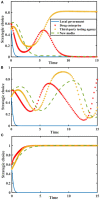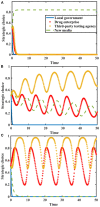Drug Quality Co-regulation Supervision Strategy Considering Collusion Behavior With New Media Participation
- PMID: 35570920
- PMCID: PMC9099224
- DOI: 10.3389/fpubh.2022.858705
Drug Quality Co-regulation Supervision Strategy Considering Collusion Behavior With New Media Participation
Abstract
The efficiency and level of drug quality supervision are highly related to the distorted or true reporting of new media, and the collusion or non-collusion of third-party testing agencies. Therefore, based on the co-regulation information platform, considering the strategic choices of local government, drug enterprises, third-party testing agencies and new media, this article constructs a four-party evolutionary game model of co-regulation supervision. The stable equilibrium points of each participant's strategic choices are solved. The stability of the strategic combination is analyzed by Lyapunov's first method, and Matlab 2020b is used for simulation analysis to verify the influence of each decision variable on different players' strategic choices. The results show that, firstly, new media's true reporting can make up for the lack of supervision of drug enterprises by local government, and the greater the impact of new media reporting, the more active drug enterprises will be to produce high-quality drugs. Secondly, non-collusion of third-party testing agencies can improve the self-discipline ability of drug enterprises, encourage new media to report truthfully, and play the role of co-regulation supervision. Furthermore, the greater the probability of new media's true reporting, the more local government tend to be stricter, and the probability of strict supervision is positively related to the central government's accountability. Finally, increasing penalty for producing low-quality drugs and collusion will help standardize the behavior of drug enterprises and third-party testing agencies. This article enriches and expands the theoretical basis of the drug quality co-regulation supervision and proposes corresponding countermeasures and suggestions.
Keywords: collusion behavior; drug co-regulation supervision; four-party evolutionary game; new media participation; simulation analysis.
Copyright © 2022 Zhang and Zhu.
Conflict of interest statement
The authors declare that the research was conducted in the absence of any commercial or financial relationships that could be construed as a potential conflict of interest.
Figures









Similar articles
-
Pharmaceutical enterprises integrity supervision strategy when considering rent-seeking behavior and government reward and punishment mechanism.PLoS One. 2025 May 19;20(5):e0320964. doi: 10.1371/journal.pone.0320964. eCollection 2025. PLoS One. 2025. PMID: 40388539 Free PMC article.
-
Drugs quality supervision strategy of different distribution channels in pharmaceutical supply chain.Front Public Health. 2022 Oct 11;10:954371. doi: 10.3389/fpubh.2022.954371. eCollection 2022. Front Public Health. 2022. PMID: 36304253 Free PMC article.
-
Pharmaceutical enterprises drug quality strategy Moran analysis considering government supervision and new media participation.Front Public Health. 2023 Jan 17;10:1079232. doi: 10.3389/fpubh.2022.1079232. eCollection 2022. Front Public Health. 2023. PMID: 36733287 Free PMC article.
-
Public health events emergency management supervision strategy considering citizens' and new media's different ways of participation.Soft comput. 2022;26(21):11749-11769. doi: 10.1007/s00500-022-07380-6. Epub 2022 Aug 16. Soft comput. 2022. PMID: 35992193 Free PMC article.
-
Analysis of Managing Safety in Small Enterprises: Dual-Effects of Employee Prosocial Safety Behavior and Government Inspection.Biomed Res Int. 2018 Mar 8;2018:6482507. doi: 10.1155/2018/6482507. eCollection 2018. Biomed Res Int. 2018. PMID: 29707574 Free PMC article. Review.
Cited by
-
Pharmaceutical Enterprises' R&D Innovation Cooperation Moran Strategy When Considering Tax Incentives.Int J Environ Res Public Health. 2022 Nov 17;19(22):15197. doi: 10.3390/ijerph192215197. Int J Environ Res Public Health. 2022. PMID: 36429914 Free PMC article.
-
An evolutionary game study on the collaborative governance of environmental pollution: from the perspective of regulatory capture.Front Public Health. 2024 Jan 5;11:1320072. doi: 10.3389/fpubh.2023.1320072. eCollection 2023. Front Public Health. 2024. PMID: 38249382 Free PMC article.
-
Pharmaceutical enterprises integrity supervision strategy when considering rent-seeking behavior and government reward and punishment mechanism.PLoS One. 2025 May 19;20(5):e0320964. doi: 10.1371/journal.pone.0320964. eCollection 2025. PLoS One. 2025. PMID: 40388539 Free PMC article.
-
Drugs quality supervision strategy of different distribution channels in pharmaceutical supply chain.Front Public Health. 2022 Oct 11;10:954371. doi: 10.3389/fpubh.2022.954371. eCollection 2022. Front Public Health. 2022. PMID: 36304253 Free PMC article.
-
Pharmaceutical enterprises drug quality strategy Moran analysis considering government supervision and new media participation.Front Public Health. 2023 Jan 17;10:1079232. doi: 10.3389/fpubh.2022.1079232. eCollection 2022. Front Public Health. 2023. PMID: 36733287 Free PMC article.
References
-
- Zhang SY, Zhu LL. Coregulation supervision strategy of drug enterprises under the government reward and punishment mechanism. Complexity. (2021) 2021:1–16. 10.1155/2021/5865299 - DOI
-
- Wu MX. Performance Evaluation of Listed Pharmaceutical Companies Based on EVA. Acad J Eng Technol Sci. (2020) 3:25–35. 10.25236/AJETS.2020.030803 - DOI
MeSH terms
LinkOut - more resources
Full Text Sources

